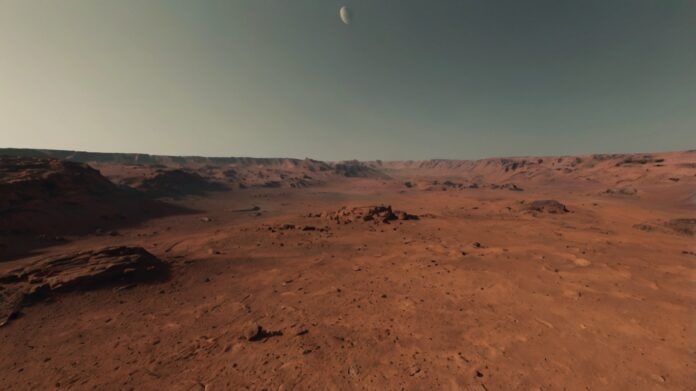A discovery that could prove crucial for understanding the history and dynamics of water on Mars.
This is not the first time frost has been identified on this planet. TGO itself had found traces of it before, especially in the polar regions. However, this is the first time its presence has been confirmed in Tharsis. It is an extraordinary region that contains 12 huge volcanoes including Raša Ascraeus, Ceraunius Tholus and especially Olympus Mons, the largest volcano in the entire solar system that rises almost 30 kilometers above sea level.
It was on top of these three geological titans that the spacecraft found the ice. Every day, for a few hours around dawn, these huge buildings are covered with a very fine whitish hair. Its thickness is little more than that of a hair, but the surface it covers is very large, and this represents a considerable amount of water; researchers estimate that at the peak of the phenomenon, the Tharsis is home to more than 110 million litres of frozen water!
This is a discovery that caught researchers off guard, because until now everyone thought that this low-latitude region was virtually incapable of hosting frost. “It was thought to be impossible around the equator of Mars, because the combination of sunlight and the rarefaction of the atmosphere maintains relatively high temperatures both at the surface and at the top of the landforms, unlike what we observe on Earth, where we expect to see icy peaks,” explains Adomas Valantinas. The postdoctoral fellow behind this discovery.
A microclimate at the origin of the phenomenon
Further studies will be needed to shed light on the mechanisms that may come into play; But the team of researchers already believes they have a pretty good idea of the situation. Their hypothesis is largely based on calderas, the vast craters left on top of volcanoes by eruptions. According to the team, air circulation over these structures creates a unique microclimate that could help frost settle in shaded areas.
“Winds climb mountain slopes, transferring relatively moist air from the surface to the peaks where it condenses as frost,” explains Nicolas Thomas, co-author of the study. “This is something that is already being seen on Earth and other parts of Mars; this same phenomenon is for example the cause of the seasonal clouds over Raša Mons,” he says.
Great news for future explorers
“Finding water on the surface of Mars is always exciting in terms of scientific interest, but also because it has many implications for human and robotic exploration. But this discovery is particularly fascinating,” says Colin Wilson, a planetary scientist at ESA.
If the presence of this material is so exciting, it’s because it will help researchers refine models that describe Mars’ atmospheric dynamics. This work could have a lot of potential implications for the planet’s geological history and even play a role in future exploration missions.
One day, a rover could explore the Olympus Mons caldera, as Perseverance is already doing in the Jezero Crater Delta. But in the long term, it’s likely that humans will visit the Red Planet as well. And when such a mission is implemented, it will be very important to know exactly where and when to look for water in any form. Although this deadline is still relatively abstract in 2024, in a few years this discovery could be remembered as an important milestone in the history of Martian exploration.















